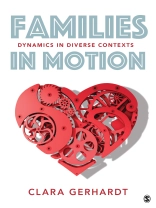Dynamics of the family can be seen as a complex set of interrelated cogs, like the dials and wheels within a sophisticated timepiece.
Families in Motion:
Dynamics in Diverse Contexts is a clear, comprehensive, and contextual view of how the dials and wheels of that complex set work together. With a focus on multicultural competence through diverse contexts and examples, this new text explores the complexities of the family regarding roles, functions, and development in a way that is approachable for students. Grounded in theory and using 40 years of academic experience, author
Clara Gerhardt guides readers through concepts of family theories and examines the ever-changing movement, communication, and conditions of both the family as a system and each member within the system. Covering approaches from the theoretical to the therapeutic,
Families in Motion will support students in extending their cultural competence while understanding families and their members with greater confidence.
Cuprins
Preface: From the Head and From the Heart
Acknowledgments
About the Author
PART I: THE DYNAMIC FAMILY SYSTEM
Chapter 1. Family Dynamics: Setting Families in Motion
Setting Families in Motion
Family Dynamics: Meaning
Lifespan Development and Family Dynamics
Why Study Family Dynamics?
Defining Families
Census Definitions
Diverse Families
The Family as a System
Functions of the Family
Chapter 2. Dimensions That Influence Dynamics
Tasks, Structure, and Context
The Influences on Dynamics
The Choreography of the Family Dance
Patterns of Family Interaction
Chapter 3. Dynamic Family Commitments
The Circle of Safety
Launching and Landing: The Dynamic Tasks of the Family
The Family Orchestra
Shaping the Dynamics of the System
Dysfunctional Families
Chapter 4. Observing Family Dynamics
Observing Families
Making Dynamics Visible
Cultural Constructions of the Family
Family Interventions
Working With Families
Chapter 5. Explaining Dynamics With Theories
Theories: Seeking Connection and Meaning
Birth of the Family Therapy Movement
Major Theoretical Paradigm Shifts
The Context of Systemic Thinking
PART II: THE DYNAMIC LANGUAGE OF THE FAMILY
Chapter 6. Communication and Family Relationships
Reaching Out and Connecting
Emotional Interactions
Power and Patterns of Decision Making
Communication in Multicultural Contexts
Cultural Echoes: Nuances in Communication
Chapter 7. Communication and Control
Family Scripts
The Power of Disinformation
Family Secrets
Professional and Work-Related Communication
Chapter 8. Changing Communication Patterns
Families in a Digital World
The Dynamics of a Digital World
Family Rituals in a Digital World
Family Communication Networks
Chapter 9. Communication and Resilience
The Pillars of Resilience
Resilience and Self-Regulation
Resilience on Various Systemic Levels
Chapter 10. Communication and Life’s Journey
Families: Constant yet Ever Changing
Dynamics of Partner Selection
Transitions and Turning Points
Lifespan-Related Theories
PART III: DYNAMICS IN DIVERSE CONTEXTS
Chapter 11. Dynamics of Loss
Grief and Mourning
Interventions: Constructivist Psychotherapy
Loss in Limbo: Ambiguous Loss
Narrative Therapy
Grief Support
Grief: The Real Story
Chapter 12. Dynamics of Power and Excess
The Dynamics of Power
The Dynamics of Excess
The Dynamics of Collecting
From Collecting to Hoarding
The Addicted System
Chapter 13. Dynamics of Family Structure and Transitions
Individual Families
Intergenerational Relationships
The Single-Child Family System
Variations in Family Structure
Blended Families
Family Transitions
Healthy Families
Chapter 14. Dynamics of Culture and Change
Culture and Change
Dynamics of International Families
Dynamics of Assimilation
Culture and Communication
Enculturation and Acculturation
Chapter 15. Dynamics of Happiness
The Intentionality of Happiness
Dynamics of Spiritual Development
Education and Public Policy
Family Connections and Rituals
Glossary
References
Index
Despre autor
Clara Gerhardt, MBA, Ph D. is a licensed Clinical Psychologist and a licensed Marriage and Family Therapist. She received extensive international training as a systemic family therapist. From the early eighties onward, she sat in the front rows as the great family therapy movement was unfolding. She attended workshops by many of the pioneers in the field, a veritable Who’s Who of family therapy that is slowly receding into history as these pioneers are passing on. This provided her with a unique and personal perspective of the early and by now historic days of family therapy. Her many publications include Parent-Child Relations: An Introduction to Parenting (2019), now in its 10th edition. She contributed a number of entries to the Encyclopedia of Family Studies (2016). She is contributing editor to a publication of the National Council on Family Relations (NCFR) and writes a regular column Perspectives. She published over a hundred articles related to popular psychology. Her academic home is at Samford University, where she is professor and past chair in Human Development and Family Science. Her favorite courses to teach are Counseling Foundations, Parenting and Multicultural Perspectives. Dr. G. – as her students call her – has presented at about 200 conferences on six continents. She is the product of three continents and speaks five languages fluently. She is exceptionally well travelled, but the best journeys are those leading home to her family.












